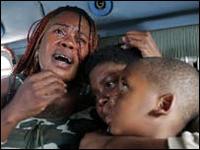 Photo from the BBC reports of Katrina
Photo from the BBC reports of KatrinaRichard Edelman eloquently and movingly describes the digital divide in his blog of 2nd September. He said of the New Orleans disaster
“There is no co-creation of the narrative as in London or during the tsunami, where the best content came from participants in the unfolding tragedy. Why? Because the tourists at Phuket were armed with digital video recording devices that could capture the oncoming wave and resulting devastation while the victims of the subway bombing who could snap photos on their cell phones.”
This is why, I believe that it is very important for PR practitioners to get to grips with the fundamentals of their professions.
We have to remember that, at its heart, PR is about changing value and creating wealth. To begin with, we have to learn to distinguish between the networks that are available to publics and the communications channels that are used by people in such networks.
In normal PR activity, this is very important but for crisis and issues management, such as the one we see before us in the USA and the emerging story of Typhoon Nabi, it is vital.
PR has to sharpen up its act (and work harder at developing the theory and practice) to be able to offer the ability to create, sustain and enhance value in the networks that are available. We have to be able to use the communications channels that are being used and we have to be able to communicate using tokens and values that are going to be bring empathetic understanding and deliver tangible value.
In New Orleans, some of the networks operated in the Superdome, some at local level and some were as small as family and care units.
4000 miles away, I could see some of the communications channels being used. They were desperate messages for help written on sheets and hung on the sides of buildings. People were waving from the flooded streets and so on. The electronic click of the mobile phone was not there, but has this wizardry blinded us to real communication? These were symbols that are important in our understanding of communication.
As PR practitioners we have to learn to recognised the breadth of networks and channels available. I try to do this when using the Social Frames because it identifies the environment, interactive capabilities and the knowledge and issues of moment and in play.
In addition, we have seen in this tragedy another facet of public relations. It is easy to us shorthand. We can use expressions like the 'people trapped' and 'victims' etc. But the truth is that this is not one homogeneous 'public' this is not a 'nexus of contracts' – the old paradigm of 19th century capitalism. This is the real network of society – the nexus of relationships. This is a lot of people in a range of circumstances and in a miscellany of relationships that are linked sometime tenuously and sometimes strongly with each other. I have tried to explain this in the theory of the Relationship Value Model but it is so eloquently exposed to our eyes along the Mississippi today.
There are some very serious lessons for PR practitioners to emerge from this event. We have the tools and educations to move from flackery to the political science and management capabilities of the practice of public relations and relationship management. In our maturing profession, we can begin to use our knowledge, skills and can deploy our domains of practice to create, sustain and enhance value. Was it more needed than for those who have lost so much and who need our capability to create wealth at this elemental level when the tokens in question are water, food, medicine and shelter?
No comments:
Post a Comment